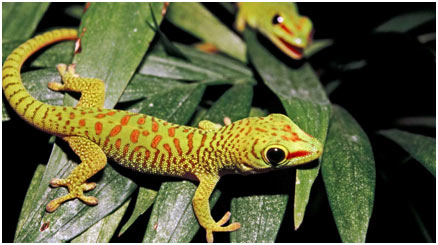Creepy and Scary Creatures
People seem to enjoy a great scare, especially on Halloween. Ghosts, zombies, vampires, and other fictional characters are good for putting a chill down your spinal column. But if you are searching for something genuinely scary, let nature be your guide. For some people, simply hearing the word “snake” or “frog” is enough to send them running.
Most animals that might look frightening actually are not. This list includes some animals with fearsome track records– some are been worthy of and some are not.
So, we inform you about some animals here. Read this, if you dare.
1.King cobra
Scientific name: Ophiophagus hannah
This snake belongs to the venomous species. It is the world’s longest venomous snake. It preys mainly on other snakes and periodically on some other vertebrates, such as lizards and rodents. It is an extremely venomous and dangerous snake when upset or provoked that has a terrifying reputation in its range, although it is usually shy and prevents the confrontation with people when possible.
The king cobra’s skin is olive green with black and white bands on the trunk that assemble to the head. The king cobra has a wide distribution in South and Southeast Asia.

2.Black mamba
Scientific name: Dendroaspis polylepis
This one also comes from the venomous types. It is the second-longest venomous snake after the king cobra. The black mamba is a long, slender, cylindrical snake. It has coffin-shape. These have a wide variety in colour, including olive, yellowish-brown, khaki, and gunmetal colours however are hardly ever black.
The black mamba inhabits a wide variety in sub-Saharan Africa; its variety includes Burkina Faso, Cameroon, Central African Republic, South Sudan, Ethiopia, Somalia, Kenya, Uganda, Tanzania, Swaziland, Zimbabwe, South Africa. It primarily preys on little vertebrates such as birds, particularly nestlings and news, and little mammals like rodents, bats, dassies, and galago.

3.Crocodile Monitor
Scientific name: Varanus Salvadorii
Varanus Salvadorii is an arboreal lizard with a dark green body marked with bands of yellow-coloured areas. It has a particular blunt snout and a very long tail. It is native to mangroves, coastal rainforests of New Guinea. Their upper teeth are long, fang-like, set vertically in the jawbone, adjusted to capture fast-moving prey such as birds, bats, and rodents.

4.Poison dart frog
Scientific name: Dendrobates leucomelas
Most types of toxin dart frogs are small, sometimes less than 1.5 cm. Most poison dart frogs are brilliantly colored, displaying warning colouration patterns to alert potential predators.

These frogs are normally found in tropical forests, including Bolivia, Brazil, Colombia, Venezuela, Guiana, Peru, Panama. They usually eat ants, mites, and termites.
5.The Iguanas
Scientific name:Iguana
These are herbivorous lizards. They consume plants and vegetation. They are commonly dispersed in tropical locations of Mexico, Central America, South America.

The predominant color of green iguanas is green, but can actually vary from brilliant green to a pale blue-gray. There are genetic variations in the color of iguanas. Some can appear browner in color, while others are almost a blue-green.
6.Boa constrictor
Scientific name: Boa constrictor

These are large non-venomous snakes. Boa constrictor can be present in Colombia, Ecuador, Peru, Venezuela, Brazil, Bolivia, Uruguay, and Argentina.
Their prey includes a wide range of little to medium-sized mammals and birds. Young boa constrictors eat little mice, birds, bats, lizards, and amphibians. Boa constrictors generally live on their own and do not engage with any other snakes. They are nocturnal; however, they might bask throughout the day when night-time temperatures are cold.
7.Leaf-Tailed Gecko
Scientific name: Uroplatus phantasticus

The species is endemic to Madagascar. The tail is flattened and has notches in their tails to more imitate a decaying leaf. The gecko comes in a variety of colours, consisting of shades of purple, orange, tan and yellow, but is often mottled brown. It is a nocturnal reptile, with appropriately big eyes, the leaf-tailed gecko moves about its rainforest environment at night feeding on insects.
8.Komodo dragon
Scientific name:Varanus komodoensis
Komodo dragon is a species of lizard present in the Indonesian islands of Komodo, Rinca, Flores, and Gili Motang.It is the largest living species of lizards. The Komodo dragon has a tail as long as its body.
They are carnivores. Komodo dragons eat by tearing big pieces of flesh and swallowing them whole. Attacks on humans are unusual, but Komodo dragons have actually been accountable for a number of human fatalities, in both the wild and in captivity.

9.Gharial
Scientific name: Gavialis gangeticus

They have a distinct head at the end of the snout, which looks like an earthenware pot known as a ghara, hence the name “gharial”. They are commonly present in the Indus River in Pakistan, the Ganges in India, the Brahmaputra River in Bangladesh to the Irrawaddy River in Myanmar. The gharial is suitably fit in searching fish undersea because of its sharp interlocking teeth and long narrow snout.
10.Horror Frog
Scientific name: Trichobatrachus robustus
The species is terrestrial but come back to the water for breeding. They have particular hairy structures present on them. Its natural habitats are subtropical or tropical wet lowland forests, rivers, and heavily degraded forest.

11.Coral snake
Scientific name:Micrurus fulvius
Coral snakes are found in scattered regions in the southern coastal plains from North Carolina to Louisiana, including all of Florida.

Coral snakes feed mainly on smaller snakes, lizards, frogs, nestling birds, small rodents, lower vertebrates, etc. Coral snakes are not aggressive or susceptible to biting and represent less than one percent of the overall variety of snake that bites each year.

